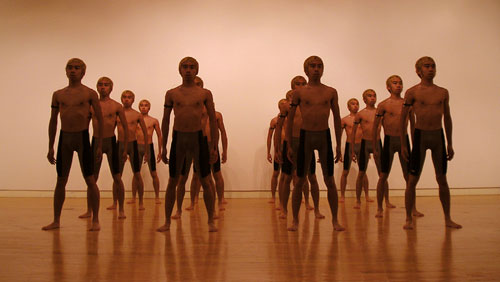Jeffrey Augustine Songco. “Emerge,” 2005, (detail). Courtesy the artist. A visible relationship of my invisible relationship with Vanessa Beecroft.
There’s a strange genre of relationships that many artists (including myself) must deal with – the invisible one. A psychologist might call it a “parasocial” relationship: a relationship where person A knows a great deal of information about person B, but person B knows little or nothing about person A. An ideal example of a parasocial relationship is that of a young pop music lover to Justin Bieber. Other examples are my relationships with Matthey Barney, Matthew Marks, and Klaus Biesenbach. A psychiatrist might call it a hallucination and give me happy pills to make the psychotic relationship go away.
My invisible relationships with other artists emerged in art school, where undergraduates are taught to research the hell out of modern and contemporary art figures. Through these repeated acts of exploration, learning, and ultimately stalking, I created a sophisticated process of developing relationships not only with artists but with their artwork and their celebrity. Teachers might call it influence or homage, but there is a deep investment in a relationship with an artist that manifests itself in the artwork that is produced during school.
After art school ends, the real crazy comes out – invisible relationships with dealers, directors, critics, and curators. Since when do artists create parasocial relationships with these types of individuals? Oh, you mean that time when I emailed Jeffrey Deitch and told him how much I loved him? Or right now, when I’m blowing kisses to Michelle Grabner, Anthony Elms, and Stuart Comer?
An image I created last year for my personal blog.
When it comes to invisible relationships, there is little to no visible evidence that any artist’s relationship to another person exists. However, there is the possibility that a work of art can evidence a relationship that exists within the artist’s own mind. It is through this type of work that the representation becomes the real thing–an invisible relationship is made visible.
Prime examples of this invisible-relationship-made-visible are the “candy” pieces by Félix González-Torres. While love, disease, and death are critical concepts behind his sculptural installations, which consist of hundreds or even thousands of pieces of wrapped candy, his parasocial relationship with us–the audience–is the defining component of the work. He created the work for us to take. He makes visible the invisible.
Google image search results for “Félix González-Torres,” from shapeandcolour.files.wordpress.com.
Contrast those works with Ryan Trecartin’s videos. Trecartin’s playfully aggressive characters break the fourth wall and look directly at us, communicating in a contemporary yet still-strange American lingo. Here, the simple eye contact between them and us is a relationship that can easily be found on any television channel today – a host speaking to and looking at us, grabbing our attention, gaining our trust, and exploiting our carnal desire for more. While we build a personal relationship with the artist/host, it is easy to forget that the artist/host is merely performing before a camera lens and not actually looking at me.
I’ll conclude with a subject that is on many people’s minds at this time of year: Christmas. With love and snow and merriment, a culture surrounds the rational thought that Santa Claus is coming to town. Whether or not you believe, we’ve subscribed to various things that visibly represent the invisible relationship we have to Santa. One piece of art, the song “Santa Baby,” is the perfect example of an invisible relationship made visible: “I really do believe in you/ Let’s see if you believe in me.” Oh, and that cookies and milk by the tree thing? Totally a takeaway art piece!
